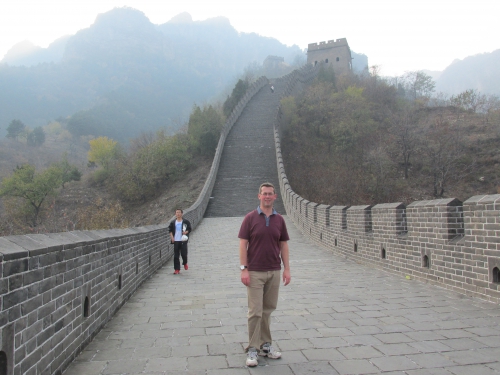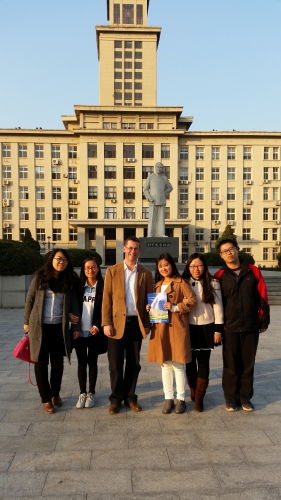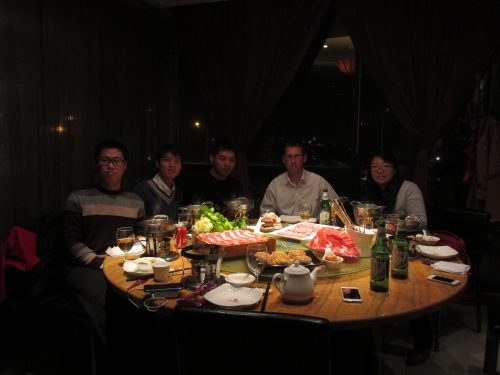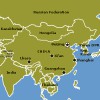Dr William Bloss is Reader on Armospheric Sciences and Deputy Head of School of Geography, Earth and Environmental Sciences at the University of Birmingham in the UK. Dr Bloss was one of the 2015 recipients of the travel grants to visit China, sponsored by the State Administration of Foreign Experts Affairs (SAFEA) and the Royal Society of Chemistry (RSC). He gives a detailed account of his visit to Nankai (Tianjin) and Beijing last November.
"Overall the visit was very interesting for me - both scientifically, and to gain a greater understanding of the career process and expectations - especially with regard to international engagement - of academic staff in China. There is amazing potential in terms of talent, and increasingly resources, to perform top-level collaborative science." says Dr Bloss.

The UK has substantial strength-in-depth in atmospheric chemistry and (sadly) in air pollution, having been in the vanguard of development of atmospheric environmental protection legislation which can be traced back to the Alkali Inspectorate and beyond, more prominently following the London smogs of the 1950s, and more recently through contributions to scientific understanding and input to (for example) WHO positions and EU policy formulation.
China is rapidly developing its atmospheric chemistry / air pollution critical mass, and the group in Nankai in particular has demonstrated strength in source apportionment - the quantitative assignment of (for example) particulate matter mass to individual sources / processes, based upon detailed analytical characterisation of particle chemical composition, physical characteristics and morphology. This was the context for the visit ahead of time.
I arrive in Beijing to a beautiful blue sky day, increasingly atypical especially in autumn / winter, and had a chance to experience the Chinese bullet train on to Tianjin at 190mph, and also into much more heavily polluted conditions. My first day at Nankai was spent meeting staff and students, having a tour of the department laboratories - at that point in the midst of the major upheaval of removal to a different campus of the University - and a tour of the campus. My visit was scheduled directly after the Chinese President, Xi Jinping, had visited the UK; I was in no doubt that this had left UK-Chinese relations in good stead - the visit was noted in conversation a number of times. In the evening we visited the Tianjin tower, for a Shard-like view over the city.
My second day was focussed around more formal business - presentation of my seminar to the School, followed by an extensive Q&A session for around an hour, formal lunch with faculty, and an afternoon “communication” or semi-formal discussion (chaired, rapporteured) around potential areas to take our mutual scientific interests forward. One focus of these was the potential complementarity of source apportionment based upon chemical composition (Nankai) and source apportionment based upon physical characteristics - aerosol size distribution - which we have recently developed at Birmingham. More generally, I was also able to discuss the forthcoming NERC-funded research projects in Beijing which a number of UK Universities (primarily Chemistry departments) will be contributing to - under the NERC - Chinese National Science Foundation
Atmospheric Pollution & Human Health in a Developing Megacity programme.

My third day was spent primarily with current graduate students and new faculty, talking through links between gas-phase atmospheric processes (a UK strength) and secondary aerosol formation on the science side, and also a very detailed discussion of publications - the merits of International vs Chinese-based journals, impact factors, and how these would be viewed on CVs etc as presented for posts at UK Universities. In the afternoon we continued our discussions alongside a little tourist activity – visiting the nearby Eastern end of the Great Wall of China for a near-vertical ascent above the valleys. The visit to Nankai concluded with a formal dinner with senior faculty from the School, hosted by Prof Feng.
My trip then took me back to Beijing, to visit the Chinese Research Academy of Environmental Sciences, host institution for a new atmospheric simulation (“smog”) chamber. I presented a research seminar, and had the opportunity for a detailed tour of the facility, and dinner with scientific staff to discuss potential future collaborations, before returning to the airport late in the evening for the journey home. Overall the visit was very interesting for me - both scientifically, and to gain a greater understanding of the career process and expectations - especially with regard to international engagement - of academic staff in China. There is amazing potential in terms of talent, and increasingly resources, to perform top-level collaborative science. I hope that the visit will also be useful - we identified potential areas for collaboration in both Nankai and CRAES - to UK atmospheric chemistry in general - and I expect to explore some of these up during a follow-up visit in March 2016.




